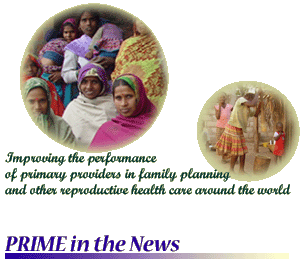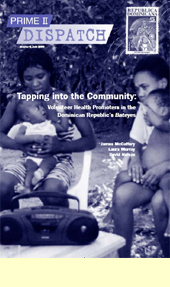 |

PRIME II Final Report
 The PRIME II Project ended on September 30, 2004. Improving the Performance of Primary Providers in Family Planning and Reproductive Health: Results and Lessons Learned from the PRIME II Project, 1999-2004 documents accomplishments and findings from the USAID-funded global initiative, which worked in 25 countries. The final report provides an overview of PRIME II’s technical leadership areas (Performance Improvement, Postabortion Care, Responsive Training and Learning, and Family Planning and HIV/AIDS Integration) and activities in reproductive health focus areas (preventing postpartum hemorrhage, safe motherhood, advocacy against female genital cutting, adolescents and gender). This website includes country-by-country descriptions of PRIME II’s work in six regions around the world, and all of the project’s publications, resources and interactive tools. The PRIME II Project ended on September 30, 2004. Improving the Performance of Primary Providers in Family Planning and Reproductive Health: Results and Lessons Learned from the PRIME II Project, 1999-2004 documents accomplishments and findings from the USAID-funded global initiative, which worked in 25 countries. The final report provides an overview of PRIME II’s technical leadership areas (Performance Improvement, Postabortion Care, Responsive Training and Learning, and Family Planning and HIV/AIDS Integration) and activities in reproductive health focus areas (preventing postpartum hemorrhage, safe motherhood, advocacy against female genital cutting, adolescents and gender). This website includes country-by-country descriptions of PRIME II’s work in six regions around the world, and all of the project’s publications, resources and interactive tools. |
 |
This website was produced by IntraHealth International for the PRIME II Project and was made possible through support
provided by the U.S. Agency for International Development, under the terms of Grant Number
HRN-A-00-99-00022-00. The views expressed in this website are those of the
authors and do not necessarily reflect the views of the U.S. Agency for
International Development.
|

|
|
| 



|













